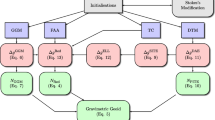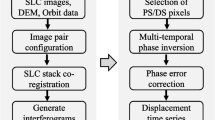Abstract
With the rapid development of digital earth, there are higher demands for the virtual of true feeling marine environments and the reveal of the rules hidden in multi-source data. First, an efficient 3D Delaunay algorithm which improves the speed by establishing relative relationship of nodes and optimizing the new tetrahedral construction is proposed to visualize the large scale dataset of scalar field, then, an adaptive visualization method to resolve the problem of overlapping effects caused by excessive noise or omitting important details caused by less noise is put forward to visualize the vector field dataset, finally, the integration of scalar field dataset and vector field dataset are visualized by the presented fusion platform. The main contributions are: (1) the improved 3D Delaunay algorithm can visualize marine temperature dataset efficiently. (2) the adaptive LIC visualization method can visualize flowing cloud data and storm surge data legibly. (3) the proposed fusion platform can visualize temperature field data and wind field data perfectly.









Similar content being viewed by others

References
Bingolbali B, Majidi AG, Akpınar A (2021) Inter- and intra-annual wave energy resource assessment in the south-western Black Sea coast. Renewable Energy 169:809–819
Bowyer A (1981) Computing Dirichlet tessellations. Comput J 24(2):162–166
Chaine R (2003) A Geometric Convection Approach of 3-D Reconstruction.Eurographics Symposium on Geometry Processing. [s.1.]: [s.n.]
Chen D, Lin Y, Liu D (2009) A fast algorithm for point location in 3-D delaunay triangulation. Comp Eng Sci 31(5):79–80
Chen Q, Liu G, Ma X et al (2018) A virtual globe-based integration and visualization framework for aboveground and underground 3D spatial objects. Earth Sci Inf 2(11):591–603
Craglia M, Bie de K, Jackson D et al (2012) Digital Earth 2020: towards the vision for the next decade. Int J Digital Earth 1(5):4–21
Doleisch H, Gasser M, Hauser H (2003) Interactive Feature Specification for Focus Context Visualization of Complex Simulation Data. In Proceedings of the Symposium on Data Visualisation, VISSYM'03, Switzerland, Eurographics Association, 239–248
Edelsbrunner H, Mucke EP (1994) Three-dimensional alpha shapes. ACM Trans Graph 13(1):43–72
Escobar JM, Montenegro R (1996) Several aspects of three-dimensional delaunay triangulation. Adv Eng Softw 27(1):27–39
https://max.book118.com/html/2019/0514/8004027076002023.shtm. Accessed 19 May 2019
Jobard B, Lefer W (1997) Creating Evenly-Spaced Streamlines of Arbitrary Density[C]. Proceedings of the Eurographics Workshop on Visualization in Scientific Computing’97, April, Springer-Verlag, 7: 43–56
Jihn-Sung L, Wen-Yi C, Ying-Chieh C et al (2011) Development of a 3D virtual environment for improving public participation: Case study – The Yuansantze Flood Diversion Works Project. Adv Eng Inform 2(25):208–223
Khalsa SJS, Borsa A, Nandigam V et al (2022) OpenAltimetry-rapid analysis and visualization of Spaceborne altimeter data. Earth Sci Inf 3(15):1471–1480
Li W, Zhu J, Fu L et al (2021) An augmented representation method of debris flow scenes to improve public perception. Int J Geogr Inf Sci 8(35):1521–1544
Li G S,Tricoche X, Hansen C (2006) GPUFLIC:Interactive and Accurate Dense Visualization of Unsteady Flows. Eurographics/IEEE-VGTC Symposium on Visualizations,May,Lisbon,Portugal, 29–33
Li S, Chen B, Zhao L et al (2007) A fast mesh generation algorithm with point-by-point delaunay insertion. Acta Sci Nat Univ Peking 43(3):302–306
Lin CF, Wan SD (2002) Fuzzy Support Vector Machines. IEEE Trans Neural Netw 13(2):464–471
Liu J, Chen B, Chen Y (2007) Boundary Recovery after 3D Delaunay Tetrahedralization without Adding Extra Nodes. Int J Numer Meth Eng 72:744–756
Macchione F, Costabile P, Costanzo C et al (2019) Moving to 3-D flood hazard maps for enhancing risk communication. Environ Model Softw 111:510–522
Miao Wenjuan, Liu Yiguang, Shi Xuelei et al (2019) A 3D Surface Reconstruction Method Based on Delaunay Triangulation. Lect Notes Comput Sci 11902(1):40–51
Peikert R, Sadlo F (2007) Topology-guided Visualization of Constrained Vector Fields. Topology-Based Methods in Visualization, Springer, 21–34
Ribeiro A, Costoya X, de Castro M, Carvalho D, Dias JM, Rocha A, Gomez-Gesteira M (2020) Assessment of hybrid wind-wave energy resource for the NW coast of Iberian Peninsula in a climate change context. Appl Sci 10:7395. https://doi.org/10.3390/app10217395
Si H (2010) Constrained Delaunay Tetrahedral Mesh Generation and Refinement. Finite Elem Anal Des 46:33–46
Talha BM, Dilip MT, Vijay N (2013) Scalar field visualization via extraction of symmetric structures. Vis Comput 29(6):761–771
Tang B, Shi H (2018) Intelligent vector field visualization based on line integral convolution. Cogn Syst Res 52:828–842
Thayyil SB, Yadav SK, Polthier K et al (2021) Local Delaunay-based high fidelity surface reconstruction from 3D point sets. Computer Aided Geometric Design 86:1–14
Thompson KE (2002) Fast and Robust Delaunay Tessellation in Periodic Domains. Int J Numer Methods Eng 55(11):1345–1366
van Wijk JJ (2003) Image Based Flow Visualization for Curved Surfaces[C].In Proceedings IEEE Visualization'03, IEEE Computer Society, 123–130
Verma V, Kao D, Pang A (2000) A Flow-Guided Streamline Seeding Strategy Proceedings of the IEEE Visualization, 163–170
Wan Y, Zhang J, Meng JM, Wang J, Dai YS (2016) Study on wave energy resource assessing method based on altimeter data-A case study in Northwest Pacific. Acta Oceanologica Sinica 35(3):117–129
Ward MO (2002) A taxonomy of glyph placement strategies for multidimensional data visualization. Inf Vis 1(3/4):194–210
Watson DF (1981) Computing the N-dimensional delaunay tessellation with application to voronoi polytopes. Comput J 24(2):167–172
William H, Saul A, William T et al (1992) Numerical recipes in C: the art of scientific computing. Cambridge University Press, New York, pp 309–315
Wittenbrink CM, Pang AT, Lodha SK (1996) Glyphs for Visualizing Uncertainty in Vector Fields. IEEE Trans Vis Comput Graph 2(3):266–279
Xia Kaijian, Yin Hongsheng, Jin Yong et al (2020) Cross-Domain Brain CT Image Smart Segmentation via Shared Hidden Space Transfer FCM Clustering. ACM Trans Multimed Comput Commun Appl 16(2s):1–21
Yamaguchi T, Kawase Y, Ishimura S (2020) 3-D adaptive FEA with weighted node density technique. COMPEL - The international journal for computation and mathematics in electrical and electronic engineering 39(5):1201–1212
Yan ZD, Liang BC, Wu GX, Wang SQ, Li P (2019) Ultra-long return level estimation of extreme wind speed based on the deductive method. Ocean Eng. https://doi.org/10.1016/j.oceaneng.2019.106900
Yan Lin, Masood Talha Bin, Sridharamurthy Raghavendra et al (2021) Scalar Field Comparison with Topological Descriptors: Properties and Applications for Scientific Visualization. Comput Graph Forum 40(3):599–633
Zhang L, Nguyen D, Thompson D et al (2018) Intelligent vector field visualization based on line integral convolution. Comput Graph 70:224–234
Zhang G, Gong J, Li Y et al (2020) An efficient flood dynamic visualization approach based on 3D printing and augmented reality. Int J Digital Earth 11(13):1302–1320
Funding
This work was supported by the Open Fund Project of Shandong Provincial Key Laboratory of Ocean Engineering, Ocean University of China (No. kloe201901), and the Open Research Fund of State Key Laboratory of Estuarine and Coastal Research (Grant number SKLEC-KF201707).
Author information
Authors and Affiliations
Contributions
Chun-xin Li presented the algorithms and wrote the whole manuscript.
Chong-wei Zheng constructed the frame of the manuscript.
Corresponding author
Ethics declarations
Competing interests
The authors declare no competing interests.
Competing financial interests
The authors declare that they have no known competing financial interests.
Additional information
Communicated by H. Babaie.
Publisher's note
Springer Nature remains neutral with regard to jurisdictional claims in published maps and institutional affiliations.
Rights and permissions
Springer Nature or its licensor (e.g. a society or other partner) holds exclusive rights to this article under a publishing agreement with the author(s) or other rightsholder(s); author self-archiving of the accepted manuscript version of this article is solely governed by the terms of such publishing agreement and applicable law.
About this article
Cite this article
Li, Cx., Zheng, Cw. High-efficiency method for 3D visualization of marine environmental information. Earth Sci Inform 16, 367–377 (2023). https://doi.org/10.1007/s12145-023-00946-4
Received:
Accepted:
Published:
Issue Date:
DOI: https://doi.org/10.1007/s12145-023-00946-4



